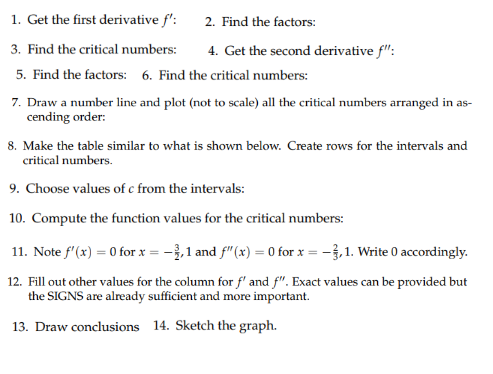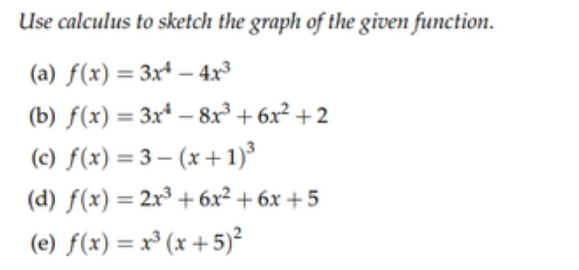1. Get the first derivative f': 2. Find the factors: 3. Find the critical numbers: 4. Get the second derivative f": 5. Find the factors: 6. Find the critical numbers: 7. Draw a number line and plot (not to scale) all the critical numbers arranged in as- cending order: 8. Make the table similar to what is shown below. Create rows for the intervals and critical numbers. 9. Choose values of c from the intervals: 10. Compute the function values for the critical numbers: 11. Note f'(x) = 0 for x = -},1 and f"(x) = 0 for x = -ž,1. Write 0 accordingly. 12. Fill out other values for the column for f' and f". Exact values can be provided but the SIGNS are already sufficient and more important. 13. Draw conclusions 14. Sketch the graph.
1. Get the first derivative f': 2. Find the factors: 3. Find the critical numbers: 4. Get the second derivative f": 5. Find the factors: 6. Find the critical numbers: 7. Draw a number line and plot (not to scale) all the critical numbers arranged in as- cending order: 8. Make the table similar to what is shown below. Create rows for the intervals and critical numbers. 9. Choose values of c from the intervals: 10. Compute the function values for the critical numbers: 11. Note f'(x) = 0 for x = -},1 and f"(x) = 0 for x = -ž,1. Write 0 accordingly. 12. Fill out other values for the column for f' and f". Exact values can be provided but the SIGNS are already sufficient and more important. 13. Draw conclusions 14. Sketch the graph.
Functions and Change: A Modeling Approach to College Algebra (MindTap Course List)
6th Edition
ISBN:9781337111348
Author:Bruce Crauder, Benny Evans, Alan Noell
Publisher:Bruce Crauder, Benny Evans, Alan Noell
Chapter1: Functions
Section1.2: Functions Given By Tables
Problem 32SBE: Does a Limiting Value Occur? A rocket ship is flying away from Earth at a constant velocity, and it...
Related questions
Question
solve letter b using the solutions provided

Transcribed Image Text:1. Get the first derivative f':
2. Find the factors:
3. Find the critical numbers:
4. Get the second derivative f":
5. Find the factors: 6. Find the critical numbers:
7. Draw a number line and plot (not to scale) all the critical numbers arranged in as-
cending order:
8. Make the table similar to what is shown below. Create rows for the intervals and
critical numbers.
9. Choose values of c from the intervals:
10. Compute the function values for the critical numbers:
11. Note f'(x) = 0 for x = -},1 and f"(x) = 0 for x = -3,1. Write 0 accordingly.
12. Fill out other values for the column for f' and f". Exact values can be provided but
the SIGNS are already sufficient and more important.
13. Draw conclusions 14. Sketch the graph.

Transcribed Image Text:Use calculus to sketch the graph of the given function.
(a) f(x) = 3x* – 4x³
(b) f(x) = 3x* – 8r° + 6x² +2
(c) f(x) = 3 – (x +1)³
(d) f(x) = 2x³ + 6x² + 6x +5
%3D
%3D
(e) f(x) = x³ (x +5)²
Expert Solution
This question has been solved!
Explore an expertly crafted, step-by-step solution for a thorough understanding of key concepts.
Step by step
Solved in 4 steps with 4 images

Recommended textbooks for you

Functions and Change: A Modeling Approach to Coll…
Algebra
ISBN:
9781337111348
Author:
Bruce Crauder, Benny Evans, Alan Noell
Publisher:
Cengage Learning

Trigonometry (MindTap Course List)
Trigonometry
ISBN:
9781337278461
Author:
Ron Larson
Publisher:
Cengage Learning

Functions and Change: A Modeling Approach to Coll…
Algebra
ISBN:
9781337111348
Author:
Bruce Crauder, Benny Evans, Alan Noell
Publisher:
Cengage Learning

Trigonometry (MindTap Course List)
Trigonometry
ISBN:
9781337278461
Author:
Ron Larson
Publisher:
Cengage Learning